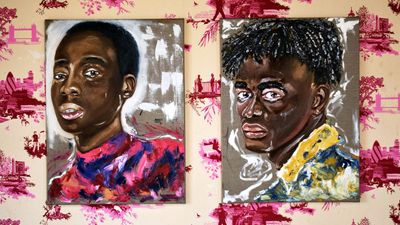‘Afro-Portraitism’ Is the New Black Art Movement You Need to Know
Artist and curator, Hamed Maiye, speaks to OkayAfrica on his new project and art movement that explores the complexities of black identity.
A big part of creating unity in a culture relies on bringing people together and collaborating. While there are many traditional forms of collaboration, young people within the diaspora are finding unique ways to elevate imagery and representation of African people.
Artist and curator Hamed Maiye is using his project, Afro-Portraitism, as a way to bring artist of different mediums together to explore the art of portraiture within the African diaspora. Afro-Portraitism uses self-representation as a way to express the complexity of the black identity and how it cannot be seen only through one light or from one perspective. Maiye has teamed up with stylist Umps Machaka, photographers Hannah Faith, Liz Knuckles and White Negatives, as well as videographer Tunde Awoyemi to use his paintings as a way to promote further exploration of his painted characters through photography and film.
The exhibition, which is co-curated by Nicole Crentsil and Annabelle Nguyen, is an extension of the original project and collaborates with more artists to explore what self expression means to each of them. Afro-Portraitism will take place at The Gallery at Republic in London on April 21 and 22.
In the meantime, check out our interview with Maiye on his inspiration behind the exhibition and the importance of collaboration within the diaspora.
Amarachi Nwosu for OkayAfrica: What inspired the name of your exhibition?
Hamed Maiye:Afro-Portraitism started as a concept—I had to create a contemporary arts movement. Each part of the name has its own significance. Afro: being of afro/Caribbean culture. Portrait: a visual representation of someone, usually through painting or photography. Ism: a practice or a movement. These three components create Afro-Portraitism, which is a movement based on self-representation, particularly for young people of the African diaspora. This movement appropriates the ways Europeans used traditional portraiture to represent themselves as important and regal. The movement itself is not fixed to being expressed through a painting or photograph but acts as a metaphor for any act of self-representation.
Why was it important that you made this exhibition a collaborative effort?
I sincerely believe that collaboration is the key to progression. A lot of young creatives feel that we’re in competition with each other, which isn’t the case. Especially since Afro-Portraitism is presented as an arts movement, solidarity is key. I believe collaboration helps people build and learn from each other.
How does working off of the art of others, allow you to express a unique story?
Working in this way allows you to step outside yourself as a creative. I feel as though it’s helped to broaden my perspective as to what art means for different people. Ultimately everyone is trying to tell a story, and bringing these different stories together helps to create a wider and more beautiful image.
Do you think art plays a key role in bridging culture and exposing African narratives?
Art plays a very important role in how we represent ourselves and the narratives that we pass down. Through sharing and expressing our art, whichever medium it may be, we learn new things about each other that change our views and perceptions. Art has always been a political practice and should continue to be, its subtle way to protest or even enlighten. The more new narratives that are exposed the more the world learns about us. Art is invaluable and important.
[oka-gallery]
